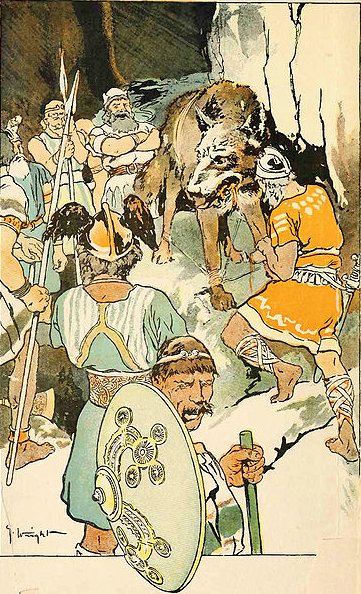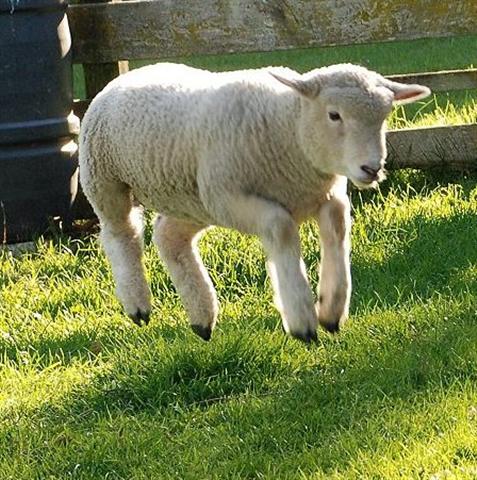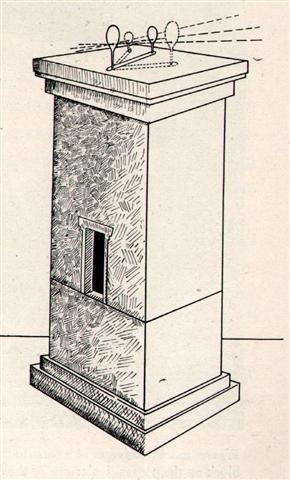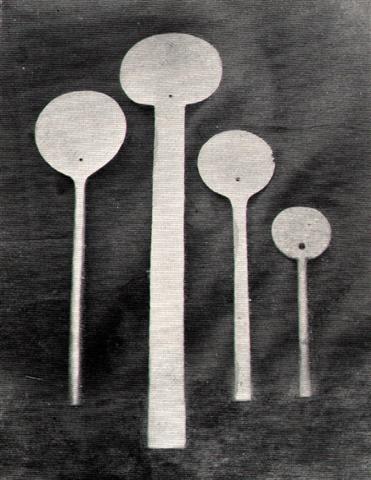|
Gao. 1. Neck. 2. Glans
penis (te gao o te kohio), neck of penis.
Vanaga. Neck, throat, (naho G); gao
pukupuku, scrofula; hore te gao, to
cut the head off; arakea gao, scrofula.
Gaogao, calm. Gaoku, to eat
greedily. Gaopu, to choke on a bone.
Churchill.
Ta. OR. Write, writing.
The name of writing before the term
rongorongo in 1871 became current. Fischer.
1. To tattoo ( = tatú), to tattoo
pictures on the skin, also: he-tá ite kona,
tá-kona. 2. To weave (a net): he-tá i te
kupega. 3. To shake something, moving it
violently up and down and from one side to the
other; he-tá e te tokerau i te maga miro,
the wind shakes the branches of the trees; also
in the iterative form: e-tá-tá-ana e te
tokerau i te tôa, the wind continuously
shakes the leaves of the sugarcane. 4. To pull
something up suddenly, for instance, an eel just
caught, dropping it at once on a stone and
killing it: he-tá i te koreha.
Tá-tá-vena-vena, ancient witching formula.
Vanaga. 1. Of. 2. This, which. 3. Primarily to
strike: to sacrifice, to tattoo, to insert, to
imprint, to write, to draw, to copy, to design,
to color, to paint, to plaster, to note, to
inscribe, to record, to describe, number,
letter, figure, relation; ta hakatitika,
treaty; ta igoa, sign; ta ki,
secretary; ta kona, to tattoo; ta
vanaga, secretary. Churchill. ... the root
ta through its long series of known
combinations carries a strongly featured sense
of action that is peripheral, centrifugal, and
there seems to be at least a suspicion of the
further connotation that the action is exerted
downward ... The secondary sense of cutting will
easily be seen to be a striking with a
specialized implement, and we find this sense
stated without recognition of the primal
striking sense only in Mangareva, Nukuoro, Viti,
and Malekula. In Indonesia this secondary sense
is predominant, although Malagasy ta may
come somewhat close to the striking idea ...
Churchill 2.
Koa. 1. Rori te koa
hogihogi, to follow a scent. 2. Joy.
Koakoa, joy, content, happiness, gay,
satisfaction, hilarity, mirth, to leap for joy,
to please, to fondle, dear; ariga koakoa,
good-humored; hakakoakoa, to rejoice, to
leap for joy. P Pau.: koa, contented,
pleased; koakoa, joy. Mgv.: koakoa,
rejoicing, joy, mirth, to be content, satisfied;
koa, to mourn. Ta.: oaóa, joy,
gladness. Churchill. Pau.: Koari, to
languish, to fade. Mgv.: koari,
half-cooked. Mq.: koaí, rotten,
insufficiently cooked. Koata, a mesh.
Ta.: oata, hole in coconuts, etc. Mq.:
oata, crevice. Churchill. Mgv.: Koai,
a plant. Ta.: oai, the wild indigo. Ma.:
koai, a plant. Akakoana-kohatu, to
make a small shapeless hole. Ma.: kohatu,
stone. Koata, light of the moon shining
before the moon rises. Ha.: oaka, a
glimpse of light. Churchill.
Kake. Kakea, to come
near, to embark. P Pau.: kake, to climb,
to ascend. Mgv.: kake, the arrival of
shoals of spawning fish. Mq.: kake, to
climb up a valley. Ta.: ae, to climb, to
ascend. Churchill. Mgv.: kake, to strike
on an ocean reef. Ta.: ae, to strand.
Churchill. Sa.: a'e, upward, to go up;
sa'e, to elevate one leg, as in the act of
falling in a club match; 'a'e, to ascend,
to rise. To.: hake, upward, to ascend.
Fu.: ake, up, to ascend; sake, ro
raise the leg at one in derision or mockery;
kake, to climb, to ascend. Niuē:
hake,
up, going up. Uvea: ake,
up; kake,
to go up. Ma.: ake,
upward; kake,
to climb, to ascend. Mq.: ake,
on high, upward; kake,
to ascend. Mgv.: ake,
upward. Bukabuka: ake,
up. Ta.: ae,
up, to go up, to ascend, to climb. Ha.:
ae, to
raise, to lift up, to mount. Fotuna:
no-jikijiake,
to lift up; no-tukake,
to stand upright. Nukuoro: kake,
to go up. Nuguria: kake,
up; hanage,
northwest. Rapanui: kake a,
to go abroad. Vi.: thake,
upward; thaketa,
to dig or lift up. Churchill 2.
Rua.
1. Two; second; other (precedes the
noun); te rua paiga, the other side. 2.
Hole, grave; holes in the rocks or between the
rocks of the coastal lagoons; he keri i te
rua, to dig a hole. 3. To vomit. Vanaga. 1.
Two. P Mgv., Ta.: rua, id. Mq.: úa.
2. Nausea, seasickness, to vomit, disgust;
hakarua, to vomit, to spew. PS Mgv.:
aruai, ruai, to vomit. Mq.: úa,
id. Ta.: ruai, id. Pau.: ruaki,
id. Sa.: lua'i, to spit out of the mouth;
lulua, to vomit. To.: lua to
vomit. Fu.: lulua, luaki, id. Niuē:
lua,
id. Viti: lua,
id.; loloa,
seasick. 3. Cave, hollow, ditch, pit, hole,
beaten path, grave; rua papaka,
a ditch. P Pau.: rua,
a hole. Mgv.: rua,
a hole in the ground, ditch, trench. Mq.:
úa, dish,
hole, cavern. Ta.: rua,
hole, opening, ditch. Churchill.
Ta.:
ruahine, an old
woman. Ma.: ruahine,
id. Ta.: ruaroa,
tropic of Capricorn. Mq.: uaoa,
a constellation, the eleventh month. The sense
in Tahiti is probably that of some constellation
which may be used to determine the position.
Ta.: ruau,
an old man, an old woman. Ha.: luau,
a parent. Churchill. |





.jpg)














